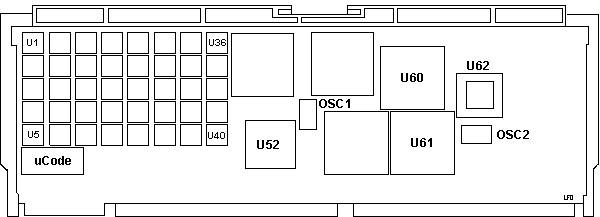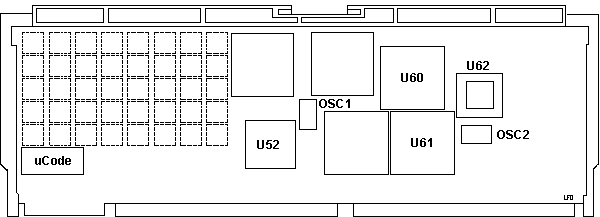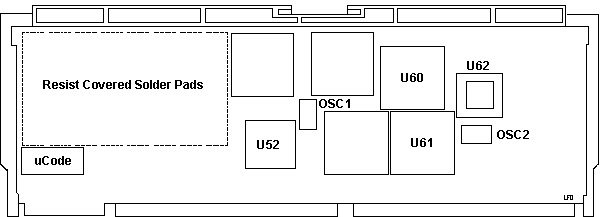|
Advanced Processor Board, model 115 P/N 08F3369, no FRU

OSC1 ?
OSC2 20.000 MHz osc (?)
U1-40 6470760ESD
U? Left top 83X2791ESD
U? Right Top 83X2789ESD |
U? Bottom Right 79X3436
U52 60X5666ESD
U60,61 92X1438ESD
U62 Motorola 68881
uCode 00F2432 |
Original image from Rick Ekblaw
20 MHz Motorola 68881 floating-point processor
The 115 had 4MB memory ON the processor card, available only on the
desktop 6151.
Has a *lot* of "yellow wires" on the back
HMS has it as P/N 08F3639
Advanced Processor Board, model 115
P/N 41F0601, no FRU

This puppy has the same layout as the 4MB 08F3369, but the upper
left is only solder pads for the little metal cans. The solder pads are
for the pins from the memory cubes.
Advanced Processor Board, model 115
P/N 59F3741, no FRU

This board has the same layout, but the area for the memory cubes
was never meant to take them. The Green resist covered solder pads are
in a rectangular pattern. I think that it's more of a ground plane than
anything...
The Advanced Processor of the 115 models have the standard features
of:
* 100 Nanosecond processor cycle time. (032 had 170 ns)
* 16 32-bit general purpose registers
* 16 32-bit system control registers, including:
- countdown timer register
- exception control registers
- interrupt request buffer register
- instruction address register
* 118 2 and 4 byte instructions with storage, branch, control,
and integer math, including multiply and divide step instruction.
* Memory Managment Unit with translation look-aside buffers,
and address translation including:
- 40-bit virtual address.
- 256 Megabyte memory segments.
- Multiple independent virtual address spaces.
- address space size of 4 gigabytes.
- demand paging.
- page size of 2048 or 4096 bytes.
- Memory protection.
- Real memory addressability of up to 16 Megabytes.
- Hardware assist for load real address
The Advanced processor (APC) has these enhancements
to the original processor.
* Overlapped Load and Store operations.
* Several instructions are serialized to allow for better memory
and I/O operations.
* Additional exception control register information.
* Instruction prefetch, and 16 byte loop detection.
* MMU allows multiple outstanding load and store requests
* On board 20 MHz MC68881 floating point processor.
- Trigonometrice and transcendental functions.
- Seven different data types and conversions.
* I/O interface enhancements.
Note: The EARLY model APC card
had 4 Meg bytes of memory ON the procssor card. It looks like a small
array of metal can chips about 1/2 inch square covering the right half
of the processor board. It is the ONLY APC card that will work with
ALL boards removed.
Thoughts on the 68881
Jeff McWilliams wrote:
Well I got some Motorola databooks today. One was
for the 68000 family. Included in there was some specs on the 68881
math coprocessor. Very interesting. The 68881 can act in either
of two ways, as a coprocessor, or as a peripheral processor. The first
way would apply to the 68881 being wired up with a 68020, where the integration
of the two is almost seamless, and the pair can be thought of as one CPU,
with floating point operands and
registers.
The second method, called peripheral processor, is so that the 68881
can interface to earlier 68xxx models, like the 68000 or 68008. In this
mode, communication between the 68881 and CPU takes place by reading and
writing to the 68881's registers, called Coprocessor Interface Registers
(CIRS) These are basically registers that you map into the CPU's
address space, much like you map a PIA (6520) registers into the 6502's
address space.
Another interesting feature of the 68881 is that it can be configured
to work with an 8 bit data bus, with some decrease in performance as compared
to its default 32 bit data bus configuration-- of course.
Additionally, the 68881 can have a separate clock attached to it, running
at either a faster or slower speed than the rest of the system, due to
the asynchronous nature of the chip.
The 68881 can also handle floating point numbers in either IEEE format
or a BCD format, much like the format used in the Atari 8 bit FP OS routines.
|